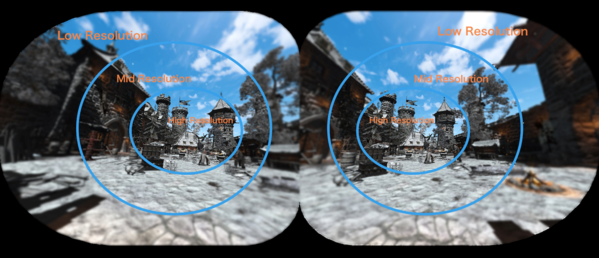 March 21, 2019 – Pimax has announced at the NVIDIA 2019 GPU Technology Conference (GTC) this week that it is officially making available its new Brainwarp version 1.0.
March 21, 2019 – Pimax has announced at the NVIDIA 2019 GPU Technology Conference (GTC) this week that it is officially making available its new Brainwarp version 1.0.
Brainwarp 1.0 includes a set of three technologies: Smart Smoothing, Fixed Foveated Rendering (FFR) and Refresh Rate Switching (RRS). The tools can be enabled or disabled individually and combined to create VR experiences on both high-end and medium-range graphics hardware, according to Pimax.
Brainwarp is a set of technologies enabled by NVIDIA VRWorks, a suite of APIs, libraries and engines that enable application and headset developers to create VR experiences. Pimax states that with NVIDIA VRWorks, Brainwarp reduces hardware requirements, limits latency, and boosts refresh rates to enable smoother VR experiences with higher quality.
“With the VRWorks SDK, you can count on the lowest latency and highest performance with leading VR headsets,” said David Weinstein, Director of Virtual Reality at NVIDIA. “NVIDIA SDK support for setting context priority helps headset developers gain finer control for switching between graphics contexts and warp contexts.”
Brainwarp’s Smart Smoothing algorithm compensates for low frame rates that can be experienced from demanding VR software titles by calculating and adding frames as necessary for an improved experience. The function will automatically switch on to allow VR applications to continue to run smoothly.
Pimax has introduced FFR to further improve the performance and reduce hardware requirements. FFR works by rendering the center of the lenses at full resolution and progressively diminishing the resolution outward toward the users’ peripheral vision. When this function is enabled, it can improve the performance VR games, according to Pimax. The specific performance improvement varies from game to game and compatibility with this feature is currently limited to NVIDIA RTX GPUs.
Pimax’s RRS feature, which can also be used in conjunction with Smart Smoothing and FFR, allows users to select the refresh rate mode (5K Plus: 90/72/64Hz, 8K: 80/72/64Hz) for their desired use with different games. Pimax states that Smart Smoothing can work with mid-level graphics cards, and that High-end graphics hardware also benefits from these techniques as they can be combined to increase super sampling, texture resolution, and anti-aliasing.
“We have worked incredibly hard on the development of Brainwarp since 2017, and we’re happy to announce its official release at GTC 2019. Empowered by NVIDIA VRWorks, we have fulfilled our goal to bring a cutting-edge immersive VR experience to our users. We truly appreciate the community for the useful feedback throughout the process of beta testing,” said Kevin Henderson, US Head of Operations and company spokesperson at Pimax VR.
Image credit: Pimax
About the author
Sam is the Founder and Managing Editor of Auganix. With a background in research and report writing, he has been covering XR industry news for the past seven years.




